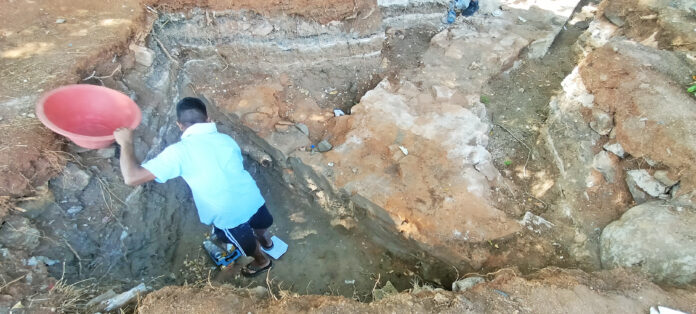There’s no doubt that Aapravasi Ghat (AG) and all the buildings surrounding this World Heritage site, rest on a subsoil filled with the vestiges of Mauritian history. Archaeological investigations at nearby Parc-à-Boulets orecently uncovered a very thick wall qthat raises many questions…
The excavation site on display at the Beekrumsing Ramlallah Interpretation Center (BRIC d’AG) shows the Vauban foundations, then the various layers that were added as the port and immigration depot were transformed. In 2020, at its 44e session in China, the World Heritage Committee invited the State of Mauritius to go ahead with a study of the documentary and archaeological resources of the Parc-à-Boulets, adjacent to the AG site.
Archival investigations helped decide which portion of the lawn with the large white anchor shouldbe excavated… by the joint National Heritage Fund (NHF ) and AG team to eventually complete the history of the Unesco-listed site.
The excavations, which began on November 15, uncovered artifacts from the French and English eras, as well as specific building materials, but above all they uncovered awall thick enough not tobe simply… that of a building. Could it be a foundation, port infrastructure or the remains of a foundry? Further studies will tell, now that the site has been interrupted by bad weather.
Forges, cooperage, slaughterhouse…
This initiative provides an opportunity to recall that this site, known as the Parc-à-Boulets from 1791, was called Les Forges in 1781. The English set up a cooperage here shortly after 1810. Diocesan archives mention the fire that destroyed the temporary chapel at Parc-à-Boulets on September 25, 1816. In 1830, a barracks was built on the site to hold Indian convicts, and in 1850, the first mayor of Port-Louis asked that the site be converted into a slaughterhouse.
In 1857, part of this site belonging to the Mauritius Dock Company was sold to expand the activities of the neighboring Immigration Depot , whichwas running out of space to accommodate engaged migrants. Parc-à-Boulets remained under the control of the Immigration Office until the end of engagism in the 1920s…
A true landmark in the heart of the port, it is still known that the workers at Parc-à-Boulets were requisitioned by the military authorities in 1914, to secure the capital. In 1934 and 1935, workers demonstrated all the way to the Parc-à-Bouletsto secure jobs. Transformed into a green space in recent decades, pedestrians and motorists alike walk along this site… every day.





